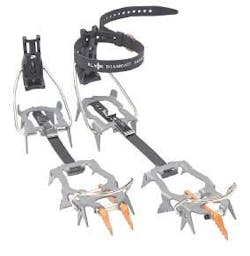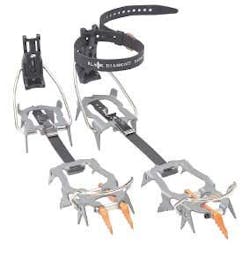Crampon cutting reaches new heights
Just when you think you've heard every good reason to select laser cutting over conventional techniques, you hear about another one. Black Diamond, the world's leading producer of equipment and accessories for "on the edge" sports, has sharpened its manufacturing edge with a new Cincinnati Incorporated CL-7A laser cutting system. This laser enables Black Diamond to produce a new design of ice-climbing crampon, bring out-sourced laser work in-house, and reduce manufacturing noise to allow multiple shifts of production without disturbing residential neighbors.
The headquarters and manufacturing operations of the company are located in a residential area of Salt Lake City, Utah, at the foot of the Wasatch Mountains. Looking to expand production, the company considered adding another stamping press, but it had a noise agreement with neighbors to run presses only during the daytime shift. This situation limited productivity and equipment payback. The low-noise laser, however, enables the company to be a good neighbor, while achieving greater operating flexibility. Not only is the company able to run the laser more hours per day, but it also is using the laser for prototyping and product development as well as production parts.
Besides operational flexibility, the laser cutting system brings superior capabilities to a complex, new design of crampons—ice-climbing "spikes" that clamp onto boot soles. Black Diamond manufactures about 10,000 pairs of crampons per year, and the laser produces all six metal components required for each crampon. The crampons' sharp points have always been a manufacturing challenge, but now the laser's tight focal spot provides a superior edge finish and point sharpness. Nitrogen assist gas further helps ensure clean edge finishes.
After laser cutting, crampons receive three to four bending and coining operations, heat treatment and powder coating. The crampons feature tight bends that can fail if the material is hardened, so parts have been annealed to make them more malleable before the bending operations. However, the company finds that nitrogen assist gas reduces the edge hardening effect to the extent that annealing may be unnecessary, reducing costs and time.
Two months after installation, Black Diamond was already running 100 different parts on the laser. Besides the crampon components, the laser cuts a variety of climbing aids such as safety pins, grappling hooks, tools to help remove gear from rock cracks, and ski binding parts that are cut from stainless and aluminum plate. It has recently started to use the laser to cut nylon fabric for ski skins, which users can attach to the bottom of downhill skis to make it easier to climb uphill.
According to Bill Reimann, director of manufacturing and process engineering, "The CL-7A provides a combination of performance and overall value for the 0.05- to 0.25-in. thick 4130 steel processed, taking initial price and operating cost into consideration." He says, "We had virtually no experience with laser cutters, but the easy-to-use control, optional programming and nesting software, and Cincinnati support flattened the new equipment learning curve. We were up and running full production in only one month."
The company has 100 employees and a wide variety of machines, including presses from 5 to 300 tons, CNC machines, grinders, lathes and test equipment, but none of its operators had much experience with laser cutters. After only a month learning all the nuances of this new machine, the company was in full production.
Programming and nesting software was another big factor in Black Diamond's decision to choose the CL-7A, according to Reimann. Close part nesting allows for maximum material usage. "We haven't crunched the numbers on material savings going from blanking to nesting on the laser, but I'd bet we're saving about 25 percent," says Reimann. "That adds up to a cost savings over $25,000 per year." The software also automatically performs sequencing, process optimization and feature avoidance, which typically require manual input by a skilled operator.
"We're about ready to run the laser on two full shifts, which wouldn't be possible with a press," says Reimann. "The CL-7A will help take both our production and R&D capabilities to a new plateau."
For more information, contact Cincinnati Incorporated at Tel. (513) 367-7165 or visit www.e-ci.com.


